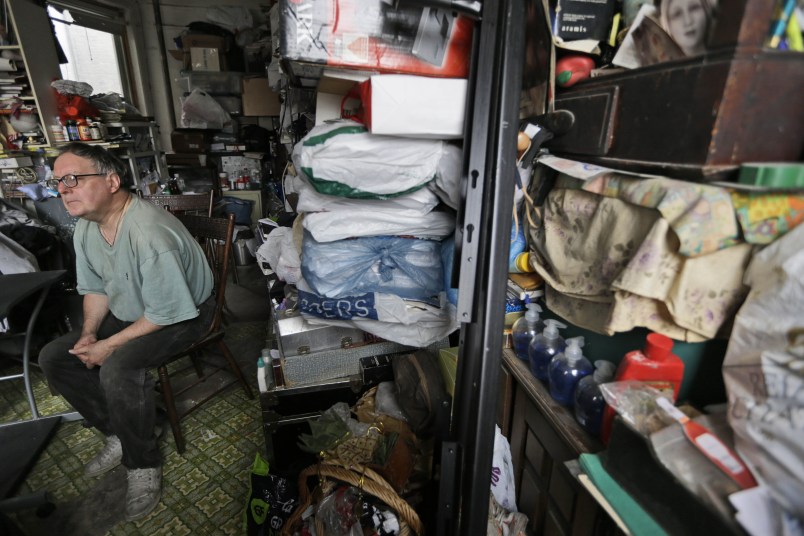NEW YORK (AP) — In the frantic aftermath of a gas explosion last year that leveled three nearby buildings, the firefighters who arrived to evacuate Adam Chrin’s fourth-floor apartment were confronted by an entirely different disaster.
They found him nearly entombed in filth and squalor, amid hoarded, floor-to-ceiling piles of old newspapers, rumpled clothes, books, shopping bags, food scraps, knickknacks and stacks of old records.
“It was like walking through a minefield,” said the 67-year-old Chrin, recalling how the firefighters could barely get inside. It was that moment of fear mixed with shame that prompted him to finally get help for a hoarding problem he had battled for decades.
Chrin is among hundreds of older, mostly poor New Yorkers who have been assisted by a private initiative that seeks to tackle not only the fetid clutter of extreme hoarding, but also the mental, legal and financial woes that are often at the root of the mess.
Experts say an estimated 2 to 5 percent of the U.S. population engages in clinically significant hoarding, the obsessive need to accumulate things. Its grim realities of squalor and isolation have become known to many through the popular cable reality series “Hoarders.”
New York’s skyrocketing real estate rates and tiny, easily cluttered apartments make it an appropriate place for the Geriatric Mental Health and Hoarding Initiative, which sends social workers to the worst public nuisance cases, in which the hoarding is so bad that residents are threatened with eviction.
Their aim is to get them into free counseling and to clear their homes enough to make them at least functional.
“We’re not Martha Stewart,” joked Jack Sherratt, the program’s director, who wears a biohazard suit and mask to protect him from bacteria and mildew when he enters dangerously cluttered apartments. He has compiled many stories of clutter that blotted out the light from windows and blocked kitchens and bathrooms. One extreme hoarder even carefully saved bottles of his own urine.
In the three years since its inception, the Hoarding Initiative, funded largely by the United Jewish Appeal-Federation of New York, has visited about 250 New Yorkers, diagnosing 100 with hoarding disorder. So far, Sherratt said, all those treated in the program have been able to evade evictions, while building up new mental health skills.
Sherratt’s three full-time staffers, plus a dozen students in social work, never force their way into anyone’s home. Instead, they gently persuade the person to participate in the cleanup and free counseling, offered through a partnership with Mount Sinai Beth Israel Medical Center and The New School, which are studying the disorder.
“We don’t know for sure what causes this, but there’s some indication genetic vulnerability and difficulties with processing and organizing information play a part, and about half of hoarders suffer from clinical depression,” said Randy Frost, a Smith College psychology professor who wrote a book on the subject, titled “Stuff.”
New York City separately spent $6 million last year on emergency cleanups of hoarded homes, partly because they can pose a hazard from what city firefighters call “Collyers’ Mansion” conditions. That’s from the infamous Harlem brownstone of brothers Homer and Langley Collyer, who were found dead in 1947 amid more than 100 tons of possessions.
After the East Village gas explosion last year that killed two people, Chrin was forced to get out of his building for several weeks while inspectors made sure it was structurally sound enough to inhabit. He called it a “blessing in disguise” that allowed him to accept help.
Chrin, a native of Paris who worked as a teacher and in other jobs, said his hoarding problems began decades ago after his mother’s death and a series of financial failures.
“I know, it’s my fault, my negligence, but when you’re hoarding, it’s like a sickness, an illness,” a wistful Chrin said as he glanced around his still-packed but functional rent-controlled apartment.
So far, he estimates he’s gotten rid of about half his clutter, clearing paths from his front door to his bedroom and creating enough space for a table and chairs. Along the way, he’s found many lost possessions but is still looking for his collection of vintage Barbie dolls, which could bring in cash to boost the savings he lives on.
Amid the clutter, he’s never lost sight of the many Jesus and Mary pictures propped up on just about anything.
“They give me hope,” he said.
Copyright 2016 The Associated Press. All rights reserved. This material may not be published, broadcast, rewritten or redistributed.



